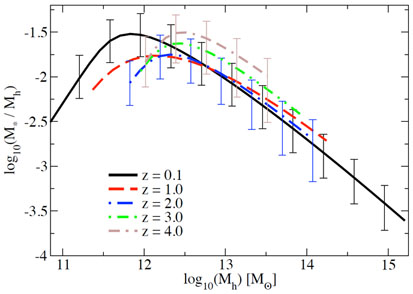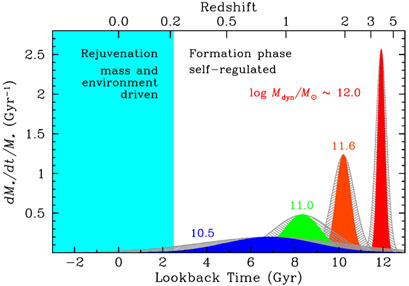


Galaxy formation theory generically favors formation of small galaxies before larger ones, and tends generically to overproduce early star formation. Observations unambiguously favor downsizing for both galaxies and for SMBH.
In order to reconcile theory and observations, what is needed is some
process which preferentially suppresses the formation of stars in lower
mass dark matter halos. The efficiency of galaxy formation must thus
depend strongly upon halo mass. Using the abundance matching technique,
[144]
constrained the relationship between stellar mass and halo mass, and
therefore the galaxy formation efficiency, and how this relationship
evolves with redshift. The idea is to match the cumulative number of
observed galaxies with the cumulative number of dark matter haloes, the
latter being derived either from theory or from cosmological N-body
simulations. Such a technique reproduces the galaxy correlation function
from SDSS galaxies; however, it does not tell us what the underlying
physics responsible for such a correlation may be.
Fig. 32 shows how the mass corresponding to the
peak efficiency for star formation evolves slowly, being a factor of
five larger at z = 4. The peak is at a halo mass of 7 ⋅
1011
M at z =
0 and increases toward higher redshift. At lower and higher masses, the
star formation is substantially less efficient. The integrated star
formation at a given halo mass peaks at 10-20% of available baryons for
all redshifts from 0 to 4. Of course, at high redshift, the statistical
uncertainties do not allow one to derive strong conclusions about the
evolution of the abundance matching relation.
at z =
0 and increases toward higher redshift. At lower and higher masses, the
star formation is substantially less efficient. The integrated star
formation at a given halo mass peaks at 10-20% of available baryons for
all redshifts from 0 to 4. Of course, at high redshift, the statistical
uncertainties do not allow one to derive strong conclusions about the
evolution of the abundance matching relation.
 |
Figure 32. Evolution of the derived stellar mass fractions for central galaxies, from z = 4 to the present. Figure from [144]. |
One of the most intriguing aspects of galaxy formation is the so-called downsizing of galaxies. While in a hierarchical galaxy formation scenario the first haloes to form are the smallest ones, there is observational evidence in favor of more massive, early-type galaxies being in place before smaller galaxies. Downsizing is observed in stellar mass from IR data to z ~ 4 [145]. It is also observed in the star formation time-scale by use of [α / Fe] as a chronometer. The α-rich elements form in SNII supernovae, formed by core-collapse of short-lived massive stars, whereas [Fe] is produced in SNIa, associated with an old stellar population and attributed to white dwarf mergers. It has been shown [146] that stars in most massive galaxies tend to have formed earlier and on a shorter time span, fig. 33
 |
Figure 33. Specific star formation rate as function of look-back time for early-type galaxies of various masses. The grey hatched curves indicate the range of possible variation in the formation time-scales that are allowed. The upper x-axis represents the redshift. These star formation histories are meant to sketch the typical formation history averaged over the entire galaxy population. Figure from [146]. |
Downsizing is observed in SMBH masses and in black hole accretion rates (via Eddington ratios) [147]. Evidence for downsizing of chemical abundances in galaxies is also found to z ~ 3 [148].
A possible explanation [149] for the downsizing phenomenon is that galaxies cannot accrete or retain cold gas in massive halos, either because of AGN feedback or because of virial shocks that prevent gas supply to the disk via the cold filaments predicted in the simulations.
Of course downsizing of galaxies is not necessarily anti-hierarchical [150]: while the main progenitor of a galaxy shows the usual hierarchical behavior, the integrated mass over all the progenitors down to a given minimum mass shows downsizing that is similar to what has been observed. In this sense, downsizing of galaxies can be partly environmental, a natural outcome of the bottom-up clustering process of dark matter haloes. This applies to star formation time-scale downsizing but not to global stellar mass downsizing: here baryonic gas physics must be invoked as discussed above.